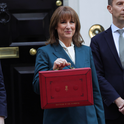Chancellor Philip Hammond leaves No 11. Photo: Kirsty O'Connor/PA Wire/PA Images
Along with yellow daffodils, one of the first sights of spring is a chancellor of the exchequer brandishing the red box outside No 11 Downing Street before heading to the House of Commons to deliver his budget. But not this year: Philip Hammond did that last November for the fiscal year starting this April. And now instead of the customary budget he will make a Spring Statement, on Tuesday 13 th March.
“Spreadsheet Phil” has reset the fiscal calendar as part of his resolve to break with the tradition of his predecessors over the past two decades in holding in effect two budgets a year, a recipe for short-term fiddling and political grandstanding. Hammond has already made clear that the Spring Statement will be drained of political colour, with no new tax-and-spend measures. Instead the chancellor will confine himself to the monochrome minimum that he is obliged to do, which is to present a new set of economic and fiscal forecasts.
The requirement for the government to publish economic forecasts at least twice a year dates back to the Industry Act of 1975 (a high-water mark as it happens for Bennite interventionism in the economy). Since 2010 the independent Office for Budget Responsibility (OBR) rather than the Treasury has carried out the economic and fiscal forecasting together with an assessment of how the government is doing in meeting its budgetary objectives. Despite Hammond’s desire to downplay the Spring Statement, the OBR’s new forecasts will cast light on the economy and public finances as the painful reality of Brexit looms ever larger.
That painful reality will be spelt out in new disclosures of annual payments to the European Union to settle the “Brexit bill,” put at between £35bn and £39bn. However, this will not change the budgetary forecasts since the OBR will continue to assume that departure from the bloc will be “fiscally neutral.”
The OBR is likely to paint somewhat brighter economic prospects than it did at the budget in November. Then it forecast GDP growth of 1.5 per cent in 2017 slipping to 1.4 per cent in 2018 and 1.3 per cent in 2019, the year that Britain is due to leave the EU. In fact the economy expanded by 1.7 per cent last year according to the Office for National Statistics. And the average of 25 new forecasts from City firms and other outfits compiled by the Treasury in February is for growth of 1.6 per cent in 2018 followed by 1.5 per cent in 2019.
“The requirement for the government to publish economic forecasts at least twice a year dates back to the Industry Act of 1975”
How well an economy is doing is in the eye of the beholder. Growth may be a little stronger than previously forecast. But it is still weak given an unusually favourable backdrop of a rebounding global and European economy. Britain’s growth of 1.7 per cent in 2017—the lowest since 2012—contrasted with 2.5 per cent in the euro area—the strongest since 2007. As Mark Carney, governor of the Bank of England, observed in January, Britain has already forfeited one percentage point of growth because of the vote to leave the EU and this will reach two percentage points by the end of 2018.
Even so, the short-term fiscal outlook also now looks brighter than the OBR envisaged in November. Tax receipts were stronger than generally expected in January, a crucial month for revenues because it includes self-assessment tax payments (due on income earned in the previous tax year, in this case 2016-17). As a result, net borrowing of £37.7bn in the ten months between April 2017 and January 2018 was the lowest for a decade.
Although the outcome for the full fiscal year ending in March remains uncertain, the budget deficit in 2017-18 may now be around £40bn rather than the £50bn predicted by the OBR in November. The OBR has already acknowledged that net borrowing will undershoot that forecast “by a significant margin.”
Indeed, in the calendar year of 2017 the current budget (which excludes net investment) ran a small surplus, the first time it has been in the black since 2001. This was an outcome that George Osborne originally sought to achieve within five years (and hoped to do so in four) when in 2010 he announced the aim of balancing the current budget (formally, in cyclically-adjusted terms).
Despite missing that goal, Osborne raised the fiscal stakes in 2015 by announcing a tougher target of getting the overall budget (including net investment) into surplus by the end of this decade. Under Hammond who is fending with a Brexit-battered economy the objective of a balanced budget has been postponed to the middle of the next decade and the Treasury now has a more feasible goal of getting the cyclically-adjusted overall deficit below 2 per cent of GDP by 2020-21.
The recent improvement in the public finances means that the deficit is already running at around that level, giving Hammond some leeway to relax fiscal policy while still ensuring that he meets that target for 2020-21. Such an easing would enable the chancellor to release more resources for hard-pressed public services suffering after years of austerity.
However, the chancellor is determined to resist any calls to splash out on 13 th March. For one thing that would immediately turn the Spring Statement back into a budget. More important, Hammond has to be cautious given the persistent damaging uncertainties arising from Brexit, in particular over how unfavourable a new trade deal with the EU will be. Britain’s quixotic exercise in economic self-harm continues to take its toll, not least in the public finances.













